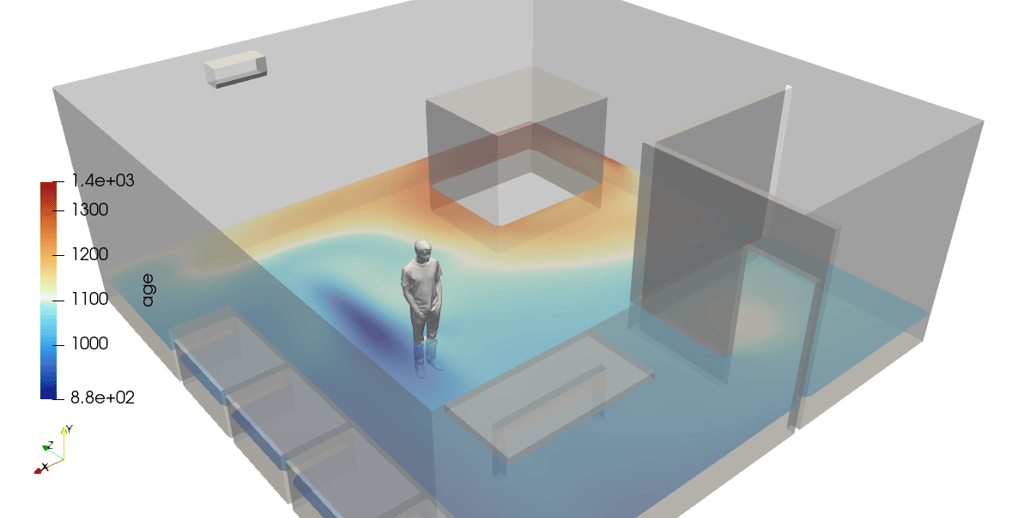HVAC Design Optimization Based on Air Age Distribution
Air age represents the time elapsed since air entered the ventilated space. It quantifies ventilation effectiveness and identifies zones where air may stagnate, leading to poor air quality.
ARTICLES
Wiratama
10/9/20253 min read


1. Introduction
In modern HVAC (Heating, Ventilation, and Air Conditioning) design, achieving thermal comfort and good indoor air quality is not only about maintaining the right temperature and humidity — it’s also about how effectively fresh air is distributed throughout a building. One of the most insightful performance indicators for evaluating ventilation effectiveness is the air age distribution.
Air age describes how long the air has remained within a particular zone since it entered the space, providing a quantitative measure of air freshness and mixing efficiency. Understanding air age distribution allows HVAC designers to identify stagnant regions, optimize diffuser placement, and improve overall ventilation performance.
2. What Is Air Age?
Air age refers to the time elapsed since a parcel of air entered the ventilated space.
In simple terms, it answers the question: “How old is the air you’re breathing?”
Young air age → indicates recently supplied, fresh air.
Old air age → indicates air that has been trapped or recirculated for a long time.
This parameter directly correlates with ventilation effectiveness, indoor air quality (IAQ), and occupant comfort. Areas with higher air age values tend to accumulate pollutants, carbon dioxide, or unwanted heat, resulting in poor comfort conditions.
3. The Role of Air Age in HVAC Design
Air age provides engineers with critical insight into how well an HVAC system is performing beyond what can be seen from temperature or velocity distributions. It helps answer key design questions such as:
Is the supplied air reaching all occupied zones effectively?
Are there stagnant areas where air does not circulate properly?
Is the return air location promoting efficient mixing or short-circuiting fresh air?
By analyzing air age distribution, designers can evaluate the true effectiveness of ventilation systems—whether in office buildings, classrooms, cleanrooms, data centers, or industrial environments.
4. Visualization of Air Age Distribution
The results of an air age simulation are usually presented as color contour maps or 3D iso-surfaces showing regions of old and young air.
Blue regions (young air) → zones with good ventilation and continuous air renewal.
Red regions (old air) → stagnant areas or poorly ventilated zones.
These visualizations help engineers optimize diffuser locations, adjust supply air velocities, or reposition return vents to ensure uniform air renewal. For example:
If a conference room corner shows older air age, it may need an additional supply vent or higher outlet velocity.
In cleanrooms, high air age near equipment may signal air recirculation that could affect contamination control.
5. Design Improvements Based on Air Age
Once air age distribution is understood, designers can make data-driven adjustments to improve ventilation performance:
Diffuser Optimization: Change diffuser orientation or type (e.g., swirl vs. slot diffusers) to enhance mixing.
Return Air Placement: Move return grilles to promote balanced air extraction and avoid short-circuiting.
Air Change Rate Adjustment: Increase air changes per hour (ACH) in zones with high air age.
Zonal Ventilation: Use displacement or underfloor systems to improve air renewal in the occupied zone.
The goal is to achieve a design where air age is uniformly low across occupied areas, ensuring every occupant receives fresh, conditioned air.
6. Advantages of Air Age–Based HVAC Design
Designing HVAC systems based on air age analysis provides several advantages:
✅ Improved Indoor Air Quality (IAQ) – Ensures better removal of CO₂ and contaminants.
✅ Enhanced Thermal Comfort – Minimizes stratification and drafts.
✅ Energy Efficiency – Enables targeted ventilation where it’s most needed.
✅ Quantifiable Ventilation Effectiveness – Offers measurable performance beyond intuition or experience.
✅ Compliance with Standards – Supports design verification under ASHRAE 129 and ISO 7730 guidelines.
7. Practical Applications
Air age distribution analysis is valuable in:
Office and commercial buildings – Optimizing occupant comfort.
Hospitals and laboratories – Ensuring contaminant removal and infection control.
Cleanrooms and manufacturing facilities – Maintaining uniform air purity.
Data centers – Managing thermal zones and preventing hotspots.
Residential HVAC systems – Improving comfort and air freshness with energy-efficient ventilation.
8. Conclusion
Air age distribution is a vital yet often overlooked aspect of HVAC design. By understanding how long air remains in different parts of a building, engineers can make precise design choices that improve ventilation efficiency, air quality, and occupant comfort.
Through advanced CFD simulation with software such as tensorHVAC-Pro, air age becomes more than just a theoretical concept—it becomes a design optimization tool that helps create healthier, more sustainable indoor environments.
